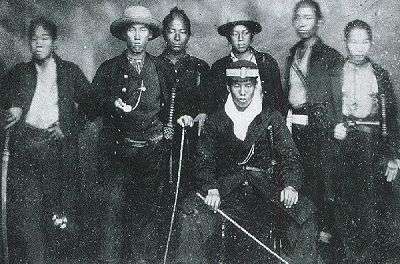Kiheitai

The Irregular Militia (Kiheitai) (奇兵隊 Kiheitai) was a volunteer militia raised by Chōshū domain during the Bakumatsu period of Japan.
Founded in 1863 by Takasugi Shinsaku, the Kiheitai militia consisted of 300-400 men, who came from all social classes, including farmers, merchants, samurai and others. Most were from Chōshū, but a few volunteers were from other domains. The Kiheitai was known for its discipline, and use of western-style weapons and military techniques. It was partly funded by the Chōshū domain, but gained the rest of its financial support through donations by wealthy merchants and farmers. Kiheitai followed a developing trend which had been spearheaded by the shogunate following the Convention of Kanagawa to form military units based on ability rather than hereditary social status. Shinsengumi, a Kyoto-based, pro-Tokugawa police force, was founded in the same year as Kiheitai, and was also composed of people from a broad variety of social classes.
The Kiheitai militia saw action in the Bombardment of Shimonoseki in 1864, during which the fleets of Great Britain, France, the Netherlands, and the United States fired upon the Chōshū port city of Shimonoseki, and subsequently landed troops. As the military arm of the pro-reform faction within the Chōshū domain, the Kiheitai helped overthrow the pro-bakufu faction in the Chōshū civil war, repulsed the Second Chōshū expedition sent by the Tokugawa bakufu in 1866, and played an important role in the Boshin War of 1868-69, which led to the Meiji Restoration.
Disbanded in 1868, the success of the socially mixed unit and its Western armaments and tactics was an important influence on the development of the Imperial Japanese Army, and on the later system of universal military conscription in Japan.
Other Usage
The forces defending Aizu-Wakamatsu during the Boshin War, and the forces of Saigō Takamori in the Satsuma rebellion also used the term ‘kiheitai’ to describe themselves.
The Kiheitai also appeared in an expansion of Creative Assembly's Total War: Shogun 2, Fall of the Samurai as special units of the Choshu domain. They are featured as an elite unit, having on par statistics with other late game elite infantry while requiring less money and time to recruit and maintain.
References
- Huber, Thomas M.: The Revolutionary Origins of Modern Japan. Stanford, California: Stanford University Press, 1981.
- Craig, Albert M.: Chôshû in the Meiji Restoration. Lanham et al.: Lexington Books, 2000.